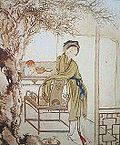Redology
 From Wikipedia - Reading time: 5 min
From Wikipedia - Reading time: 5 min


Redology (simplified Chinese: 红学; traditional Chinese: 紅學; pinyin: hóng xué) is the academic study of Cao Xueqin's Dream of the Red Chamber,[2] one of the Four Great Classical Novels of China. There are numerous researchers in this field; most can be divided into four general groups: the first group are the commentators, such as Zhou Chun, Xu Fengyi, Chen Yupi, and others; the second group is the index group, which includes Wang Mengruan and Cai Yuanpei; the third group are the textual critics, including Hu Shih and Yu Pingbo; the final group are the literary critics, including Zhou Ruchang and Li Xifan.
History
[edit]A 1976 essay by Joey Bonner split the Chinese critical reception of the novel into five phases:[3]
- Pre-1791
- Commentators on the pre-publication manuscripts, such as Rouge Inkstone and Odd Tablet, who mainly provide literary analysis of the first 80 chapters.
- 1791–1900
- Post-publication questions over authorship of the addendum, speculation upon esoteric aspects of the book. After 1875 using the term "Redology" for the studies.
- 1900–1922
- Political interpretations.
- 1922–1953
- "New Redology" led by Hu Shih, approach questions of textual authenticity, documentation, dating, and a strong autobiographical focus. The labelling of previous periods as "Old Redology".
- 1954–current [1975]
- Marxist literary criticism, the book seen as a criticism of society's failures. Li Xifan's criticism of both Old Redology and Neo-Redologists such as Hu Shih and Yu Pingbo.
Academic research institutes
[edit]There are many Redology academic institutions, especially university affiliated ones:
- The Society of the Dream of the Red Chamber (中国红楼梦学会) in Beijing
- The Cao Xueqin Society of Beijing (北京曹雪芹学会) in Beijing
- The Cao Xueqin Center for Aesthetics and Art (北京大学曹雪芹美学艺术研究中心) at Peking University, Beijing
- The Weiming Society for Hongloumeng Studies at Peking University, Beijing
- International Research Center of the Dream of the Red Chamber (RDRC), National Dong Hwa University College of Humanities and Social Sciences, Taiwan[4]
- Dream of the Red Chamber Research Centre, University of Malaya, Malaysia
References
[edit]- ^ Yu, Anthony C. (2001). Rereading the Stone: Desire and the Making of Fiction in Dream of the Red Chamber. Princeton University Press. p. 9. ISBN 0691015619.
- ^ Jonathan Spence, The Search for Modern China (New York: Norton, 1990), 106–110. ISBN 0-393-30780-8.
- ^ Berry, Margaret (18 October 2010). The Chinese Classic Novels (Routledge Revivals): An Annotated Bibliography of Chiefly English-Language Studies. Routledge. ISBN 9781136836589.
- ^ "國際紅學研究中心 - 國立東華大學". rdrc.ndhu.edu.tw. Retrieved 2024-03-23.
Further reading
[edit]- Zhou Ruchang. Between Noble and Humble: Cao Xueqin and the Dream of the Red Chamber, edited by Ronald R Gray and Mark S. Ferrara. New York:Peter Lang, 2009
 KSF
KSF